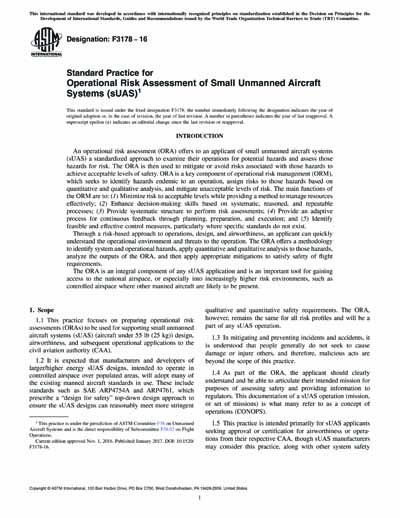Most recent
ASTM F3178-16
Standard Practice for Operational Risk Assessment of Small Unmanned Aircraft Systems (sUAS)
1.1 This practice focuses on preparing operational risk assessments (ORAs) to be used for supporting small unmanned aircraft systems (sUAS) (aircraft under 55 lb (25 kg)) design, airworthiness, and subsequent operational applications to the civil aviation authority (CAA).
1.2 It is expected that manufacturers and developers of larger/higher energy sUAS designs, intended to operate in controlled airspace over populated areas, will adopt many of the existing manned aircraft standards in use. These include standards such as SAE ARP4754A and ARP4761, which prescribe a “design for safety” top-down design approach to ensure the sUAS designs can reasonably meet more stringent qualitative and quantitative safety requirements. The ORA, however, remains the same for all risk profiles and will be a part of any sUAS operation.
1.3 In mitigating and preventing incidents and accidents, it is understood that people generally do not seek to cause damage or injure others, and therefore, malicious acts are beyond the scope of this practice.
1.4 As part of the ORA, the applicant should clearly understand and be able to articulate their intended mission for purposes of assessing safety and providing information to regulators. This documentation of a sUAS operation (mission, or set of missions) is what many refer to as a concept of operations (CONOPS).
1.5 This practice is intended primarily for sUAS applicants seeking approval or certification for airworthiness or operations from their respective CAA, though sUAS manufacturers may consider this practice, along with other system safety design standards, as appropriate to identify sUAS design and operational requirements needed to mitigate hazards.
1.6 Units—The values stated in inch-pound units are to be regarded as the standard. The values given in parentheses are mathematical conversions to SI units that are provided for information only and are not considered standard.
1.7 This standard does not purport to address all of the safety concerns, if any, associated with its use. It is the responsibility of the user of this standard to establish appropriate safety and health practices and determine the applicability of regulatory limitations prior to use.
Content Provider
ASTM International [astm]






